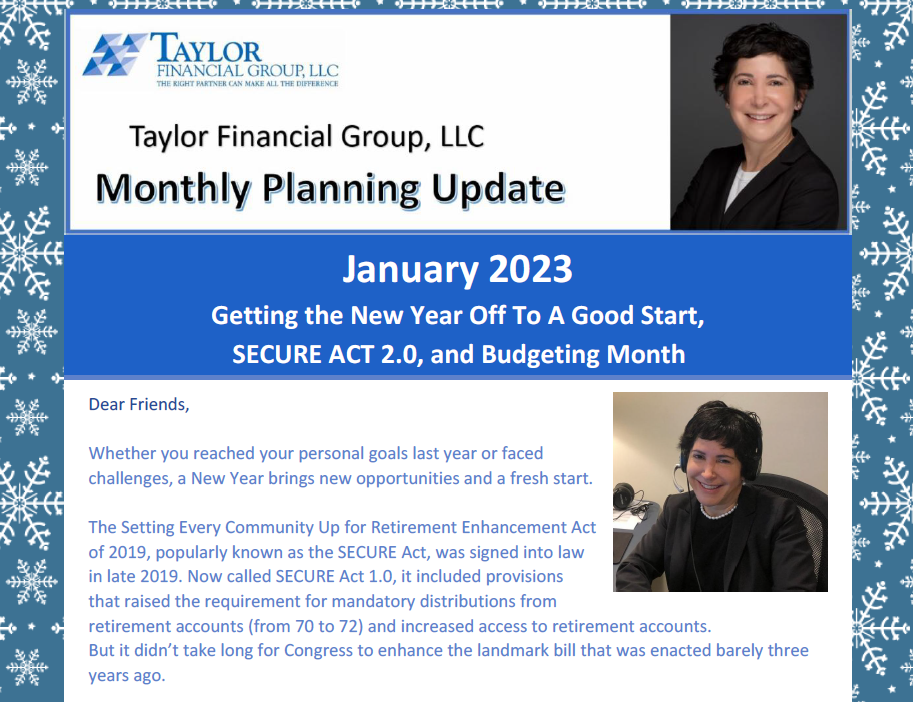By Debra Taylor, CPA/PFS, JD, CDFA™
Dear Friends,
Whether you reached your personal goals last year or faced challenges, a New Year brings new opportunities and a fresh start.
The Setting Every Community Up for Retirement Enhancement Act of 2019, popularly known as the SECURE Act, was signed into law in late 2019. Now called SECURE Act 1.0, it included provisions that raised the requirement for mandatory distributions from retirement accounts (from 70 to 72) and increased access to retirement accounts. But it didn’t take long for Congress to enhance the landmark bill that was enacted barely three years ago.
Tucked inside a just-passed 4,155-page, $1.7 trillion spending bill are plenty of goodies, including another overhaul of the nation’s retirement laws. Dubbed SECURE Act 2.0, the bill enjoys widespread bi-partisan support and builds on SECURE Act 1.0 by strengthening the financial safety net by encouraging Americans to save for retirement.
9 Key Takeaways on SECURE Act 2.0
1. Changing the age of the required minimum distributions (RMD’s). Three years ago, SECURE ACT 1.0 increased the age for taking the required minimum distribution, or RMD, to 72 years from 70½. If you turn 72 this year, the age required for taking your RMD rises to 73 with 2.0. If you turned 72 in 2022, you’ll remain on the prior schedule. If you turn 72 in 2023, you may delay your RMD until 2024, when you turn 73. Or you may push back your first RMD to April 1, 2025. Just be aware that you will be required to take two RMDs in 2025, one no later than April 1 and the second no later than December 31. Starting in 2033, the age for the RMD will rise to 75. Employees enrolled in a Roth 401(k) won’t be required to take RMDs from their Roth 401(k). That begins in 2024. In our view, the SECURE Act 1.0 and 2.0 updates were long overdue. The new rules recognize that Americans are living and working longer.
2. RMD penalty relief. Beginning this year, the penalty for missing an RMD is reduced to 25% from 50%. And 2.0 goes one step further. If the RMD that was missed is taken in a timely manner and the IRA account holder files an updated tax return, the penalty is reduced to 10%. But let’s be clear, while the penalty has been reduced, you’ll still pay a penalty for missing your RMD.
3. A shot in the arm for employer-sponsored plans. Too many Americans do not have access to employer plans or simply don’t participate. Starting in 2025, companies that set up new 401(k) or 403(b) plans will be required to automatically enroll employees at a rate between 3% and 10% of their salary. The new legislation also allows for automatic portability, which will encourage folks in lowbalance plans to transfer their retirement account to a new employer-sponsored account rather than cash out. In order to encourage employees to sign up, employers may offer gift cards or small cash payments. Think of it as a signing bonus. Employees may opt out of the employer-sponsored plan.
4. Increased catchup provisions. In 2025, 2.0 increases the catch-up provision for those between 60 and 63 from $6,500 in 2022 ($7,500 in 2023 if 50 or older) to $10,000, (the greater of $10,000 or 50% more than the regular catch-up amount). The amount is indexed to inflation. Catch-up dollars are required to be made into a Roth IRA unless your wages are under $145,000.
5. Charitable contributions. Starting in 2023, 2.0 allows a one-time, $50,000 distribution to charities through charitable gift annuities, charitable remainder unitrusts, and charitable remainder annuity trusts. One must be 70 ½ or older to take advantage of this provision. The $50,000 limit counts toward the year’s RMD. It also indexes an annual IRA charitable distribution limit of $100,000, known as a qualified charitable distribution, or QCD, beginning in 2023.
6. Back-door student loan relief. Starting next year, employers are allowed to match student loan payments made by their employees. The employer’s match must be directed into a retirement account, but it is an added incentive to sock away funds for retirement. Additional provisions
7. Disaster relief. You may withdraw up to $22,000 penalty-free from an IRA or an employer-sponsored plan for federally declared disasters. Withdrawals can be repaid to the retirement account.
8. Help for survivors. Victims of abuse may need funds for various reasons, including cash to extricate themselves from a difficult situation. 2.0 allows a victim of domestic violence to withdraw the lesser of 50% of an account or $10,000 penalty-free.
9. Rollover of 529 plans. Starting in 2024 and subject to annual Roth contribution limits, assets in a 529 plan can be rolled into a Roth IRA, with a maximum lifetime limit of $35,000. The rollover must be in the name of the plan’s beneficiary. The 529 plan must be at least 15 years old. In the past, families may have hesitated in fully funding 529s amid fears the plan could wind up being overfunded and withdrawals would be subject to a penalty. Though there is a $35,000 cap, the provision helps alleviate some of these concerns. * * *
We welcome these changes to our retirement laws. Many Americans lack adequate savings, and the just-enacted Bill helps address some of the challenges many face as they march toward retirement. What we have provided here is a high-level overview of the SECURE ACT 2.0. Keep in mind that it is not all-inclusive.
I have also included an article on SECURE ACT 2.0 and a checklist on Issues You Should Consider At the Start of The New Year and. We are always here to assist you, answer your questions, and tailor any advice to your needs.
Please reach out to us if you have any questions.
Debbie


